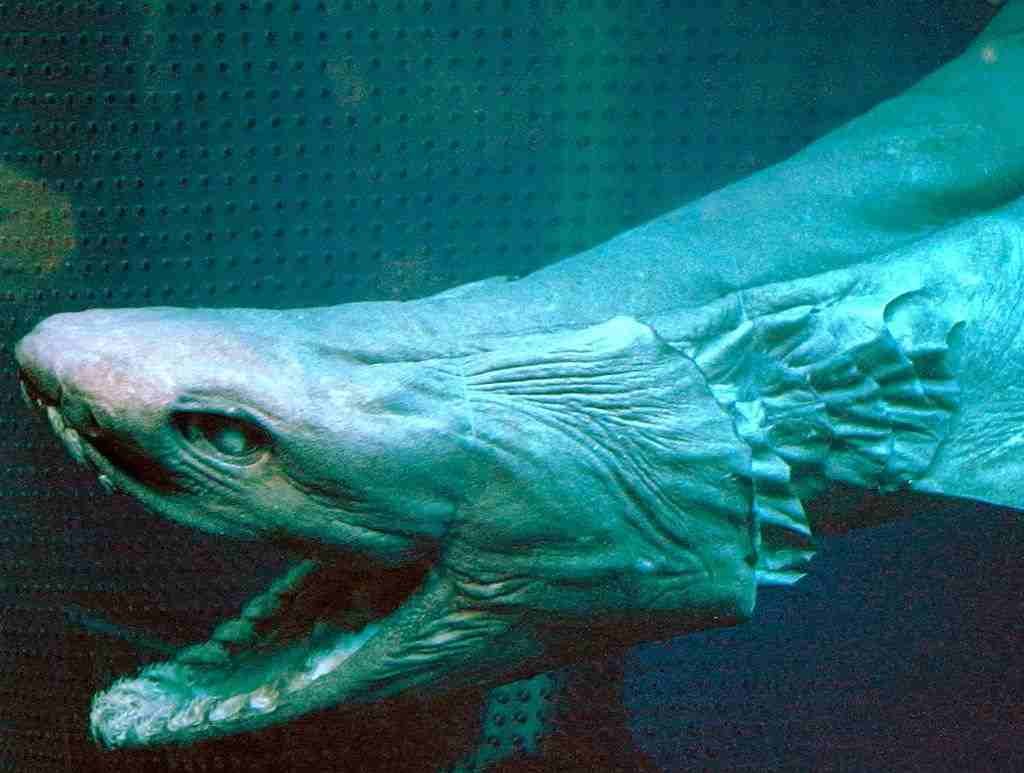Frilled Shark
Frilled Shark are often called “living fossils” because they have evolved little since they first appeared on Earth more than 80 million years ago. This distant cousin of other sharks like the great white shark and the hammerhead shark, has been roaming the depths of the ocean since the age of the dinosaurs.
This Frilled Shark, is about 1.50 meters long, has 300 teeth and was caught by a trawler at a depth of more than 700 meters.
The shark’s 300 teeth may sound scary, and they actually pose a great threat to the fish and squid that this sea monster feeds on. Just like the modern shark, the frilled shark has an articulated jaw that can catch large prey.
Characteristics
These sharks have lived on Earth for about 80 million years without any obvious changes in their anatomy, which is why they are considered living fossils. However, these anatomical features are beneficial for this species, so they have allowed it to live in the oceans for so long.
One of its main features is the presence of a large number of teeth, possessing up to 300 tooth structures, quite sharp and deadly for its prey. Teeth are found in their strong jointed jaws, giving them the ability to devour large animals.
Its long body has fins in the dorsal, pelvic and anal region, the latter being larger than the dorsal. Besides, it also has other fringed fins at the 6 pairs of gill slits. Its color is dark brown, it can measure up to 3 meters in length and looks like an eel or a lizard.
Habitat
The frill shark is a demersal or benthopelagic species, so it inhabits the depths of the ocean, although in some cases it has also been reported as pelagic, that is, in shallower areas, probably to search prey.
The temperatures of its habitat are variable, from cold waters like the Arctic of Norway or the British Isles, to warmer waters like Suriname, Guyana and French Guiana. Although there are no precise data on the evolution of its population, one of the places where it is most seen is in Japan, where it has been observed at shallow depths.
Due to the fact that deep-sea fishing has become widespread in several of the countries that correspond to the range of this species, scientists are increasingly concerned about its chances of survival.
Habits
The frilled shark is a species that is not common to observe, so there are few traces of its behavior. Although it can be present at depths of 20 to 1,500 meters, they generally prefer to live between 500 and 1,000 meters deep. When they ascend to shallower areas, they do so at night.
Read also: Stung by Jellyfish | What to do if you get stung by it?
This species of shark is not dangerous to humans, although it can cause significant injuries to the hands of scientists when handling them for study. They are solitary and slow-moving animals with a life expectancy of about 25 years. However, since he was not kept in captivity for research purposes, this information has yet to be corroborated.
Diet
Frill sharks are fierce hunters. It is very difficult for prey to escape when caught, as it nimbly jumps on it, bending its body like a snake before capturing the victim. In many cases they swallow the prey whole and, when this is not possible, they hold it with their large number of sharp teeth, from which it is impossible to detach.
They usually camouflage quite well with their color and hunt at night. They are carnivorous animals with a varied diet, they generally feed on:
- Fish.
- Octopus.
- Squid.
- Other sharks.
Reproduction
This shark is a viviparous species and its gestation period is estimated between 1 and 2 years. They can produce from 2 to 15 offspring in each gestation, and these can measure up to 60 cm in length. Fertilization is internal, so the two individuals must unite so that the male can introduce the sperm as they reach the female’s oviducts. The process occurs through a maneuver of their body, in which the male holds the female.
This shark is probably matrotrophic, that is, the embryos hatch from the egg inside the mother and remain there for a long period of time, feeding on the yolk of their own egg. This species is not known to have fixed breeding seasons.
Conservation status of the frilled shark
The International Union for Conservation of Nature has identified the frilled shark in the category of least concern. However, reports indicate that although it is not a particularly persecuted species, deep-sea trawling has increased, so incidental catches of this shark may also increase. In fact, accidents of this type have been highlighted and the captured individuals are ultimately used to produce fishmeal.
In some countries where these sharks live, there are certain restrictions on deep sea trawling, which reduces the risk of accidental capture. In Japan, this animal can be seen in food markets and aquariums, although it is a species that should not be kept in captivity.
The frilled shark is not currently considered endangered, however, given its sporadic presence, it is difficult to establish its population levels with any precision. Currently, in the European Union, there are measures that establish a zero catch limit for all species of sharks, a measure that benefits this species. In areas of southern and eastern Australia, fishing grounds below 700 meters are closed, an aspect that favors many species, including the shark in question.
It is essential to continuously monitor the levels of fishing in the oceans globally, as it is one of the causes that significantly affects the populations of marine animals.
Sources: PinterPandai, Sharkopedia, NPR, Marinebio
Photo credit: Author: OpenCage (CC BY-SA 2.5) via Wikimedia Commons
Main photo description: Frilled shark (Chlamydoselachus anguineus)



